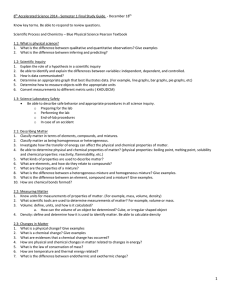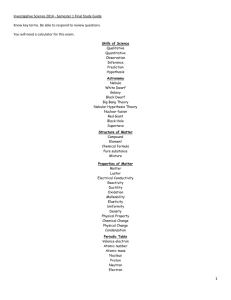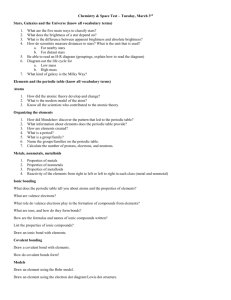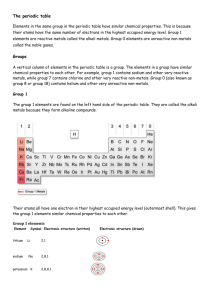8th Grade Final Study Guide
advertisement
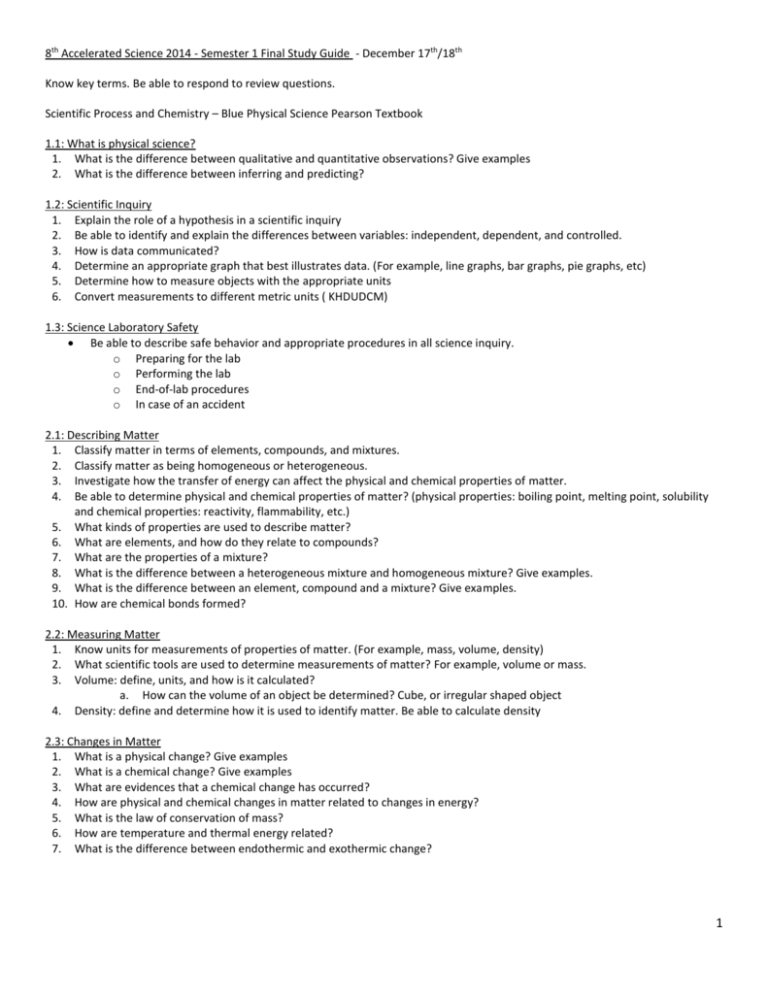
8th Accelerated Science 2014 - Semester 1 Final Study Guide - December 17th/18th Know key terms. Be able to respond to review questions. Scientific Process and Chemistry – Blue Physical Science Pearson Textbook 1.1: What is physical science? 1. What is the difference between qualitative and quantitative observations? Give examples 2. What is the difference between inferring and predicting? 1.2: Scientific Inquiry 1. Explain the role of a hypothesis in a scientific inquiry 2. Be able to identify and explain the differences between variables: independent, dependent, and controlled. 3. How is data communicated? 4. Determine an appropriate graph that best illustrates data. (For example, line graphs, bar graphs, pie graphs, etc) 5. Determine how to measure objects with the appropriate units 6. Convert measurements to different metric units ( KHDUDCM) 1.3: Science Laboratory Safety Be able to describe safe behavior and appropriate procedures in all science inquiry. o Preparing for the lab o Performing the lab o End-of-lab procedures o In case of an accident 2.1: Describing Matter 1. Classify matter in terms of elements, compounds, and mixtures. 2. Classify matter as being homogeneous or heterogeneous. 3. Investigate how the transfer of energy can affect the physical and chemical properties of matter. 4. Be able to determine physical and chemical properties of matter? (physical properties: boiling point, melting point, solubility and chemical properties: reactivity, flammability, etc.) 5. What kinds of properties are used to describe matter? 6. What are elements, and how do they relate to compounds? 7. What are the properties of a mixture? 8. What is the difference between a heterogeneous mixture and homogeneous mixture? Give examples. 9. What is the difference between an element, compound and a mixture? Give examples. 10. How are chemical bonds formed? 2.2: Measuring Matter 1. Know units for measurements of properties of matter. (For example, mass, volume, density) 2. What scientific tools are used to determine measurements of matter? For example, volume or mass. 3. Volume: define, units, and how is it calculated? a. How can the volume of an object be determined? Cube, or irregular shaped object 4. Density: define and determine how it is used to identify matter. Be able to calculate density 2.3: Changes in Matter 1. What is a physical change? Give examples 2. What is a chemical change? Give examples 3. What are evidences that a chemical change has occurred? 4. How are physical and chemical changes in matter related to changes in energy? 5. What is the law of conservation of mass? 6. How are temperature and thermal energy related? 7. What is the difference between endothermic and exothermic change? 1 3.1: States of Matter 1. What are the characteristics between a solid, liquid, and a gas? 3.2: Changes of State 1. What happens to a substance during changes between solid and liquid? 2. What happens to a substance during changes between liquid and gas? 3. What happens to a substance during changes between solid and gas? 4. Are changes in state a physical or chemical property of matter? 5. How is energy related to changes of states of matter? 4.1: Introduction to Atoms 1. Describe the particles of an atom. What are the particles and where are they found? a. Nucleus, protons, neutrons, electrons, and energy levels 2. What is the atomic number? 3. What is the relationship between isotopes and mass number? 4.2: Organizing the Elements 1. What information about elements does the periodic table provide? 2. What are periods and groups? 3. Why are groups also known as families? 4. What are the characteristics of each family based upon? 5. How are groups identified? 6. How do you read the periodic table? Refer to pages 112 and 113. a. How do you read an element’s square? 7. How does the periodic table change as it moves left to right? Atomic Number? Atomic mass? 8. How can you make predictions about the location of elements on the periodic table? 9. What are some trends as you move across the periodic table? Down? 4.3: Metals 1. What are the physical properties of metals? Give examples. 2. What are the chemical properties of metals? Give examples. 3. How does the reactivity of metals change across the periodic table? 4. Where are the most reactive metals found on the periodic table? 5. Identify the group numbers of the alkali metal, alkaline earth metal, and transition metals. 4.4: Nonmetals and Metalloids 1. What are properties of nonmetals? 2. What are the physical properties of nonmetals? Examples. 3. What are the chemical properties of nonmetals? Examples 5.1: Atoms and Bonding 1. What particles in the atom are involved in the bonding of atoms? 2. How is the reactivity of elements related to valence electrons in atoms? 3. What does the periodic table tell you about atoms and the properties of elements? 4. What are valence electrons and where are they found on the atom? 5. Why are valence electrons important in chemical bonds? 6. How does the arrangement of the periodic table tell you about the arrangement of electrons in atoms? (If you know the number of valence electrons that atoms of different elements have, you have a clue as to which elements combine and how.) 5.2: Ionic Bonds 1. What are ions, and how do they form bonds? 2. How are the formulas and names of ionic compounds written? 3. What are the properties of ionic compounds? 2 5.3: Covalent Bonds 1. What is a covalent bond and how are they formed? 2. How does the unequal sharing of electrons occur? 6.1: Observing Chemical Change 1. How are energy and chemical reactions related? 2. How can matter and changes in matter be described? 3. How can you tell when a chemical reaction occurs? Evidence. 4. What are physical and chemical properties of matter? Examples. 5. Classify changes in matter as a physical or chemical change? Examples. 6. What is the relationship between bonding and chemical changes? 7. What is the difference between an endothermic and exothermic reaction? Describe the changes in energy. 6.2: Describing Chemical Reactions 1. What are chemical equations? 2. What information does a chemical equation contain? 3. Identify reactants and products in a chemical equation. 4. What does the principal of conservation of mass state? 5. Balance simple chemical equations based on the law of conservation of mass. 7.1: Understanding Solutions 1. What are the two parts of a solution? Examples 2. What is the difference between solute and solvent? 3. How does a solute affect the freezing and boiling points of a solution? 7.2: Concentration and Solubility 1. Why is solubility useful in identifying substances? 2. What factors affect solubility? 7.3 and 7.4: Describing Acids & Bases and Acids and Bases in Solution 1. What are the properties of acids and bases? Give examples 2. What does the pH of a solution tell you? 3. How are the strengths of acids and bases determined? 4. What is the pH scale and how is it read? Life Science – refer to the Biology Pearson Textbook 2.2: Properties of Water 1. Explain how a water molecule is made up. 2. Why are water molecules polar? 3. Explain the importance of water (SMEBR). 2.3: Carbon Compounds 1. What are the 4 key carbon compounds? 2. Identify the structure of each compound. 3. What is the biological importance for each? 7.1: Life is Cellular 1. What does the cell theory state? 2. What are the characteristics of prokaryotes and eukaryotes? 3. Give examples of common prokaryotes and eukaryotes. 7.2 Eukaryotic Cell Structure 1. What are the main organelles in a plant cell? 2. What are their functions? 3. What are the main organelles in an animal cell? 3 4. What are their functions? 5. Compare and contrast an animal cell with a plant cell. 10.1 Cell Growth 1. Why do cells undergo mitosis? 2. What type of cells perform mitosis? 10.2 Cell Division 1. What are the main events of the cell cycle? 2. What are the four phases of mitosis? 3. Identify the phases of mitosis from diagrams. 11.4 Meiosis 1. What happens during the process of meiosis I and meiosis II? 2. What is the purpose of meiosis? 3. What type of cells perform meiosis? 4. How are meiosis and mitosis similar? 5. How are meiosis and mitosis different? 6. What are three things that attribute to genetic diversity in meiosis? 7. Identify the phases of meiosis from diagrams. Microscopes 1. What are the parts of a microscope? 2. How do you focus a slide? 4
